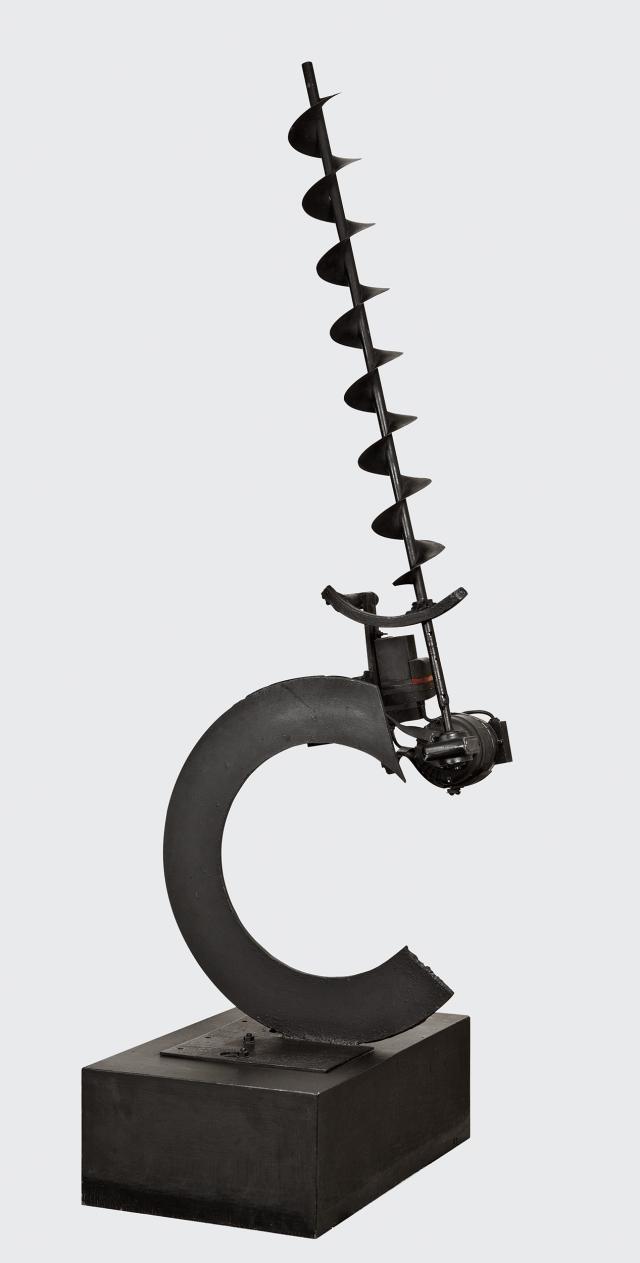Whilst from the very first Jean Tinguely’s art falls clearly in the category of sculpture in motion, from the mid-1960s on his output can be broken down into several distinct groups. He created mechanical sculptures that were often accompanied by sketches, tackled large-scale projects that might take several years to complete, and also had a hand in gigantic collective works which he developed in collaboration with other artists.
Grande Spirale (Large Spiral) belongs to the mechanical sculptures that were done on a human scale. A playful pointless machine, Grande Spirale springs to life as passers-by and their inclinations dictate. Stripped of all exterior covering, the piece exposes its mechanism, the usually hidden parts of its works, structure and a motor that only serves to make the thing whirl around to no purpose. Grande spirale glorifies its own uselessness and shows movement for the sake of movement.
Wholly fashioned from mechanical rubbish and materials recycled from the world of industry, Tinguely’s work is the antithesis of progress. His machines are both forms and producers of forms; they are never subservient to efficiency. Jury-rigged according to a principle of joyous ingenuity that is underscored again and again by the clanging and clatter they make, they are inexorably doomed to come apart.
Starting in 1963 his art took on a new aspect when the chaotic-looking assemblages gave way to works that were uniformly painted flat black. As the artist pointed out, “The colour black in a way guarantees for the machine the homogeneity of form. It’s a return to sculpture, I mean almost conventional sculpture… in its physical aspect. Obviously movement once again creates the unexpected… movement remains a phenomenon that isn’t as ‘classic’ as all that…”
Like Grande spirale, the forms of his sculptures became clearer, more compact. Tinguely would continue working with scrap metal and found materials, but the elegant black colour relegates the origin and nature of the different components to the background whilst lending them a formal unity that only goes to underscore the hypnotic attraction of movement purely for the sake of movement, which is activated and hums in an infinite spiral.
Grande Spirale (Large Spiral) belongs to the mechanical sculptures that were done on a human scale. A playful pointless machine, Grande Spirale springs to life as passers-by and their inclinations dictate. Stripped of all exterior covering, the piece exposes its mechanism, the usually hidden parts of its works, structure and a motor that only serves to make the thing whirl around to no purpose. Grande spirale glorifies its own uselessness and shows movement for the sake of movement.
Wholly fashioned from mechanical rubbish and materials recycled from the world of industry, Tinguely’s work is the antithesis of progress. His machines are both forms and producers of forms; they are never subservient to efficiency. Jury-rigged according to a principle of joyous ingenuity that is underscored again and again by the clanging and clatter they make, they are inexorably doomed to come apart.
Starting in 1963 his art took on a new aspect when the chaotic-looking assemblages gave way to works that were uniformly painted flat black. As the artist pointed out, “The colour black in a way guarantees for the machine the homogeneity of form. It’s a return to sculpture, I mean almost conventional sculpture… in its physical aspect. Obviously movement once again creates the unexpected… movement remains a phenomenon that isn’t as ‘classic’ as all that…”
Like Grande spirale, the forms of his sculptures became clearer, more compact. Tinguely would continue working with scrap metal and found materials, but the elegant black colour relegates the origin and nature of the different components to the background whilst lending them a formal unity that only goes to underscore the hypnotic attraction of movement purely for the sake of movement, which is activated and hums in an infinite spiral.
